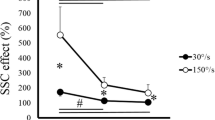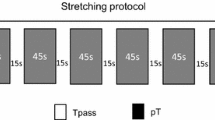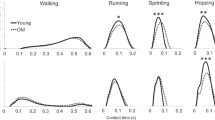Abstract
Exposure to unaccustomed eccentric exercise causes muscle damage. Pop** sarcomere theory [1] has been proposed and assumed that eccentric contraction-induced muscle damage predominantly occurs at muscle length on the descending limb of the force-length relationship. This study investigated changes in the mechanical properties following maximum effort eccentric exercise at systematically different muscle lengths for the human ankle dorsiflexors. The results of this study showed that the eccentric exercise of the ankle dorsiflexors decreased the peak torque, shifted the optimal joint angle towards longer muscle length without changes in the level of muscle activation. However, no difference in the shift of the optimal ankle joint angle was observed between the groups that performed eccentric exercise at long muscle length (ECC_L) and at short muscle length (ECC_S). In conclusion, the muscle length at which the eccentric exercise was performed did not produce differential effects on the neuro-mechanical properties of in-vivo human ankle dorsiflexors, and thus the pop** sarcomere theory might not be the sole mechanism to account for the eccentric contraction-induced optimal muscle length change.

Similar content being viewed by others
References
Morgan DL, Allen DG (1999) Early events in stretch-induced muscle damage. J Appl Physiol 87:2007–2015
Faulkner, J.A., Brooks, S.V., & Opiteck, J.A. (1993). Injury to skeletal muscle fibers during contractions pp. conditions of occurrence and prevention. Phys Ther 73:911–921.
McCully KK, Faulkner JA (1985) Injury to skeletal muscle fibers of mice following lengthening contractions. J Appl Physiol 59:119–126
Newham DJ, Mills KR, Quigley BM, Edwards RH (1983) Pain and fatigue after concentric and eccentric muscle contractions. Clin Sci 64:55–62
Ebbeling, C.B., & Clarkson, P.M. (1989). Exercise-induced muscle damage and adaptation. Sports Med (Auckland, N.Z.), 7, 207–234. doi:10.2165/00007256-198907040-00001
Hough T (1902) Ergographic studies in muscular soreness. J Physiol 7:76–92
Schwane JA, Johnson SR, Vandenakker CB, Armstrong RB (1983) Delayed-onset muscular soreness and plasma CPK and LDH activities after downhill running. Med Sci Sports Exerc 15:51–56
Jones C, Allen T, Talbot J, Morgan DL, Proske U (1997) Changes in the mechanical properties of human and amphibian muscle after eccentric exercise. Eur J Appl Physiol 76:21–31. doi:10.1007/s004210050208
Katz B (1939) The relation between force and speed in muscular contraction. J Physiol 96:45–64
Morgan DL, Claflin DR, Julian FJ (1996) The effects of repeated active stretches on tension generation and myoplasmic calcium in frog single muscle fibres. J Physiol 497:665–674
Whitehead NP, Allen TJ, Morgan DL, Proske U (1998) Damage to human muscle from eccentric exercise after training with concentric exercise. J Physiol 512(Pt 2):615–620. doi:10.1111/j.1469-7793.1998.615be.x
Wood SA, Morgan DL, Proske U (1993) Effects of repeated eccentric contractions on structure and mechanical properties of toad sartorius muscle. Am J Physiol 265:C792–C800
Brockett CL, Morgan DL, Proske U (2001) Human hamstring muscles adapt to eccentric exercise by changing optimum length. Med Sci Sports Exerc 33:783–790. doi:10.1097/00005768-200105000-00017
Chen TC, Nosaka K, Sacco P (2007) Intensity of eccentric exercise, shift of optimum angle, and the magnitude of repeated-bout effect. J Appl Physiol 102:992–999. doi:10.1152/japplphysiol.00425.2006
Chapman D, Newton M, Sacco P, Nosaka K (2006) Greater muscle damage induced by fast versus slow velocity eccentric exercise. Int J Sports Med 27:591–598. doi:10.1055/s-2005-865920
Nosaka K, Newton M, Sacco P, Chapman D, Lavender A (2005) Partial protection against muscle damage by eccentric actions at short muscle lengths. Med Sci Sports Exerc 37:746–753. doi:10.1249/01.MSS.0000162691.66162.00
Paschalis, V., Koutedakis, Y., Baltzopoulos, V., Mougios, V., Jamurtas, A.Z., & Giakas, G. (2005). Short vs. long length of rectus femoris during eccentric exercise in relation to muscle damage in healthy males. Clin Biomech (Bristol, Avon) 20:617–622. doi:10.1016/j.clinbiomech.2005.02.011
Prasartwuth O, Allen TJ, Butler JE, Gandevia SC, Taylor JL (2006) Length-dependent changes in voluntary activation, maximum voluntary torque and twitch responses after eccentric damage in humans. J Physiol 571:243–252. doi:10.1113/jphysiol.2005.101600
Saxton JM, Donnelly AE (1996) Length-specific impairment of skeletal muscle contractile function after eccentric muscle actions in man. Clin Sci 90:119–125
Yeung SS, Yeung EW (2008) Shift of peak torque angle after eccentric exercise. Int J Sports Med 29:251–256. doi:10.1055/s-2007-965337
Hill AV (1953) The mechanics of Active Muscle. Proc R Soc Lond B Biol Sci 141:104–117. doi:10.1098/rspb.1953.0027
Lee H-D, Kim S, Kawakami Y (2008) Alterations in the neuro-mechanical properties of human ankle dorsiflexor after maximum eccentric exercise. Korean J Sports Biomech 18:21–30
Rassier DE, Herzog W, Pollack GH (2003) Dynamics of individual sarcomeres during and after stretch in activated single myofibrils. Proc R Soc Lond B Biol Sci 270:1735–1740. doi:10.1098/rspb.2003.2418
Griffiths, R.I. (1991). Shortening of muscle fibres during stretch of the active cat medial gastrocnemius muscle the role of tendon compliance. J Physiol 436:219–236.
Kawakami Y, Muraoka T, Ito S, Kanehisa H, Fukunaga T (2002) In vivo muscle fibre behaviour during counter-movement exercise in humans reveals a significant role for tendon elasticity. J Physiol 540:635–646. doi:10.1113/jphysiol.2001.013459
Author information
Authors and Affiliations
Corresponding author
Rights and permissions
About this article
Cite this article
Lee, HD., Kim, SJ., Lee, DY. et al. Shift in Optimal Joint Angle of the Ankle Dorsiflexors Following Eccentric Exercise. Exp Mech 50, 661–666 (2010). https://doi.org/10.1007/s11340-009-9245-6
Received:
Accepted:
Published:
Issue Date:
DOI: https://doi.org/10.1007/s11340-009-9245-6




